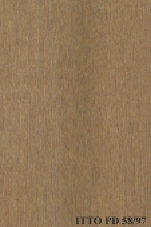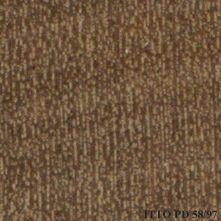
AFINA (Strombosia pustulata)
Trade Name
Afina
Scientific Name
Strombosia pustulata Oliv.
Family
OLACACEAE
Common Names
Itako (Nigeria); Afina (Ghana); Poé (Côte d`Ivoire); Mba esogo (Equatorial Guinea)
Description Of The Tree
Botanical Description
The tree reaches a height of 20 to 32 m. The bole is straight and clear up to 8 m in length. The trunk diameter attains 80 cm.
Natural Habitat
Strombosia pustulata is found in primary forests, on the coast in tropical zones.
Natural Distribution
West Africa, mainly in Nigeria.
Wood Identification
Anatomic Description Of Wood
Wood diffuse porous. Vessels in radial multiples of 2 to 4. Tangential diameter of vessel lumina 100 micras or less (very small). Non-vestured pits. Vessels per mm2 more than 20 (very abundant). Scalariform perforation plates with more than 15 bars. Vessel-ray Apotracheal axial parenchyma diffuse and/or diffuse in aggregates. Prismatic crystals in chambered axial parenchyma cells and/or in fibers. Over 9 cells per parenchyma strand. Rays more than 10 per mm (abundant). Rays non-storied. Rays 1 to 4 seriate. Prismatic crystals in radial alignment in procumbent ray cells (chambered cells). Prismatic crystals in the ray cells. Heterogeneous rays and/or multiseriate heterogeneous rays. Non-septate fibers. Fibers with simple to minutely bordered pits.
-
 Wood Macro Photo Tangential Plane
Wood Macro Photo Tangential Plane
-
 Wood Micro Photo Of Transversal Section
Wood Micro Photo Of Transversal Section
Availability
Cites Status
Unrestricted
General Wood Description
Color
The sapwood is yellow. The heartwood is brown or pale brown with purple streaks, it is clearly demarcated.
COLOR INDEX (1=Black, 7=Light yellow,white)
3
Grain
Straight; grain has no particular influence on drying, machining and finishing qualities.
Texture
The wood is frequently reported to be fine textured.
Luster
It is reported to be moderate in luster.
Natural Durability
Durable to decay; this species can be utilized without preservative treatment for exterior joinery or similar uses. Resistant to termites attack. Heartwood is resistant to Lyctus attacks.
Natural durability index (1= Very high durability, 7=Vey low durability)
1
Internal Growth Stresses
Residual growth stresses are absent.
Resistance To Impregnation
Nearly impossible to treat with a too much low penetration of the preservative substances.
Wood Physical Properties
Basic Density or Specific Gravity (O.D. weight/vol. green) (g/cm³)
0.84
Air-dry Density (Weight and volume at 12%MC) (g/cm³)
0.97
Total shrinkage Tangential (Saturated to 0%MC) (%)
10.2
Total shrinkage Radial (Saturated to 0%MC) (%)
7.1
Drying Defects
Ease of Drying: Drying is moderately easy; some particular care is needed. Drying Defects: Risks of checks, distortions and discoloration caused by decay Kiln Schedules: The kiln schedule has been tested.
Recommended Dry Kiln Schedule
FR-13
Dimensional stability ratio (Total Tangential Shrinkage %/Total Radial Shrinkage %)
1.4
Wood Chemical Properties
Wood Mechanical Properties
Bending Strength (MOR),12%MC (kgf/cm²)
1770
Stiffness (MOE) 12%MC (kgf/cm²)
208323
Compression parallel to fiber 12%MC (kgf/cm²)
924
Compression perpendicular to fiber 12%MC (kgf/cm²)
141
Janka hardness (side) 12%MC (kgf)
1185
Janka hardness (end grain) 12%MC (kgf)
1197
Workability
Sawing
Sawing of this species requires powerful equipment.
Rotary Veneer Cutting
Not suitable for veneering.
Sliced Veneer
Not suitable for veneering.
Blunting Effect
Moderate blunting effect; stellited blades for sawing and carbide tools for machining are advised.
Machining
It needs powerful tools for processing. Possible difficulties caused by interlocked grain are reported.
Planing
Moderately easy; tools must be cautiously sharpened.
Moulding
Easy; no particular problems.
Turning
30
Boring
Easy; no particular problems.
Mortising
Easy; no particular problems.
Nailing
Pre-boring is necessary.
Gluing
Difficult to glue because of high density.
Sanding
Easy to perform; it gives good results.
Polishing
Can be polished without surface preparation.
Response To Hand Tools
Working with hand tools is difficult.
REFERENCED USES
End Uses Summary
EXTERIOR GENERAL, poles, paling, stakes posts, piers, HOUSING GENERAL, beams, joists, FURNITURE AND CABINETS, cabinets, TURNING, PACKING, heavy packing, CONTAINERS, truck bodies, truck flooring, OTHER AND MUSICAL INSTRUMENTS, handicrafts, axle
Exterior General
- 1 - Tabela de resultados de ensaios fisicos e mecanicos
Poles
- 3 - Estudo dendrologico e determinacao das caracteristicas fisicas e mecanicas do genipapo (Genipa americana)
Paling Fence Pickets
- 4 - Estudo dendrologico e determinacao das caracteristicas fisicas e mecanicas da bicuiba
Stake Posts
- 5 - Propriedades fisicas e mecanicas da madeira e do contraplacado de Pinus elliottii
Piers
- 9 - Maderas latinoamericanas. IV, Nectandra sp. Ocotea austinii, Persea sp. aff. vesticula, Persea schiedeana
General Housing
- 10 - Silica in Timbers
Beams
- 11 - Prospect: The wood database
Joists
- 12 - Tropical timbers of the world. Part I-Tropical American Species
Furniture Cabinets
- 21 - Tropical timbers of the world. Part III-Southeast Asian and Oceanian Species.
Cabinet
- 24 - Empire Timbers
Turning
- 30 - Embassy of Honduras in Japan
Heavy Packing
- 47 - Arvores Brasileiras
Truck Body
- 53 - Timbers of the New World
Truck Flooring
- 54 - Bulletin of the Government Forest Experiment Station N.157: Identification of Tropical Woods
Handcraft
- 66 - Maderas latinoamericanas. VII. Caracteristicas anatomicas. propiedades fisicomecanicas, de secado, y tratabilidad de la madera juvenil de Cordia alliodora (Ruiz & Pav. Oken.)
Axles
- 73 - Handbook of Hardwoods
Please Provide Information To View Producer Information